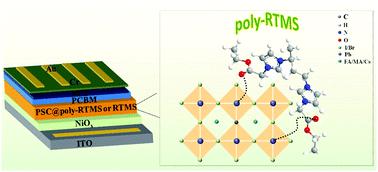当前位置:
X-MOL 学术
›
Energy Environ. Sci.
›
论文详情
Our official English website, www.x-mol.net, welcomes your
feedback! (Note: you will need to create a separate account there.)
Polymeric room-temperature molten salt as a multifunctional additive toward highly efficient and stable inverted planar perovskite solar cells
Energy & Environmental Science ( IF 32.4 ) Pub Date : 2020-10-13 , DOI: 10.1039/d0ee02043e Shuangjie Wang 1, 2, 3, 4, 5 , Bowen Yang 6, 7, 8, 9, 10 , Jian Han 1, 2, 3, 4, 5 , Ziwei He 1, 2, 3, 4, 5 , Tongtong Li 1, 2, 3, 4, 5 , Qi Cao 1, 2, 3, 4, 5 , Jiabao Yang 1, 2, 3, 4, 5 , Jiajia Suo 6, 7, 8, 9, 10 , Xuanhua Li 1, 2, 3, 4, 5 , Zhike Liu 3, 11, 12, 13 , Shengzhong (Frank) Liu 3, 11, 12, 13 , Chao Tang 13, 14, 15, 16, 17 , Anders Hagfeldt 6, 7, 8, 9, 10
Energy & Environmental Science ( IF 32.4 ) Pub Date : 2020-10-13 , DOI: 10.1039/d0ee02043e Shuangjie Wang 1, 2, 3, 4, 5 , Bowen Yang 6, 7, 8, 9, 10 , Jian Han 1, 2, 3, 4, 5 , Ziwei He 1, 2, 3, 4, 5 , Tongtong Li 1, 2, 3, 4, 5 , Qi Cao 1, 2, 3, 4, 5 , Jiabao Yang 1, 2, 3, 4, 5 , Jiajia Suo 6, 7, 8, 9, 10 , Xuanhua Li 1, 2, 3, 4, 5 , Zhike Liu 3, 11, 12, 13 , Shengzhong (Frank) Liu 3, 11, 12, 13 , Chao Tang 13, 14, 15, 16, 17 , Anders Hagfeldt 6, 7, 8, 9, 10
Affiliation

|
The inferior power conversion efficiency (PCE) compared to their regular counterparts (n–i–p) and undesirable stability issues of inverted (p–i–n) perovskite solar cells (PSCs) are the foremost issues hindering their commercialization. Here, for the first time, we demonstrate a polymeric room-temperature molten salt (poly-RTMS), namely poly(1-vinyl-3-ethyl-acetate) imidazole tetrafluoroborate (PEa), as a novel type of additive to modulate the perovskite crystallization and its electronic properties. The PEa poly-RTMS containing multiple chemical anchoring sites along with strong bonding stability can firmly bond to Pb ion defects at grain boundaries and the interface of the perovskite film via coordination bond, which effectively passivates the electronic defects and enhances the photo-, thermal-, and moisture-stability of perovskite films. As a result, the PEa-modified inverted PSCs show striking performance improvements over the control with the PCE exceeding 21.4% and excellent long-term operational stability, maintaining over 92% of the initial efficiency for 1200 hours under continuous full sun illumination at 70–75 °C. This strategy opens a new avenue to modulate the properties of perovskites for optoelectronic applications.
中文翻译:

高分子室温熔融盐作为多功能添加剂,可用于高效,稳定的倒置平面钙钛矿太阳能电池
功率转换效率(PCE)与常规功率转换效率(n–i–p)相比,以及倒置(p–i–n)钙钛矿型太阳能电池(PSC)的不良稳定性问题是阻碍其商业化的首要问题。在这里,我们首次展示了一种聚合物室温熔融盐(poly-RTMS),即聚(1-乙烯基-3-乙基-乙酸)咪唑四氟硼酸酯(PEa),作为一种新型的添加剂来调节钙钛矿结晶及其电子性质。含有具有强结合稳定性沿着多个化学锚接部位豌豆聚RTMS可以牢固地粘结到铅离子的缺陷在晶界处和钙钛矿薄膜的界面经由配位键,可有效钝化电子缺陷并增强钙钛矿薄膜的光,热和湿气稳定性。结果,经PEa改性的反向PSC在控制方面表现出惊人的改进,PCE超过21.4%,并且具有出色的长期运行稳定性,在70- 75℃。该策略为调制钙钛矿的光电特性开辟了一条新途径。
更新日期:2020-11-05
中文翻译:

高分子室温熔融盐作为多功能添加剂,可用于高效,稳定的倒置平面钙钛矿太阳能电池
功率转换效率(PCE)与常规功率转换效率(n–i–p)相比,以及倒置(p–i–n)钙钛矿型太阳能电池(PSC)的不良稳定性问题是阻碍其商业化的首要问题。在这里,我们首次展示了一种聚合物室温熔融盐(poly-RTMS),即聚(1-乙烯基-3-乙基-乙酸)咪唑四氟硼酸酯(PEa),作为一种新型的添加剂来调节钙钛矿结晶及其电子性质。含有具有强结合稳定性沿着多个化学锚接部位豌豆聚RTMS可以牢固地粘结到铅离子的缺陷在晶界处和钙钛矿薄膜的界面经由配位键,可有效钝化电子缺陷并增强钙钛矿薄膜的光,热和湿气稳定性。结果,经PEa改性的反向PSC在控制方面表现出惊人的改进,PCE超过21.4%,并且具有出色的长期运行稳定性,在70- 75℃。该策略为调制钙钛矿的光电特性开辟了一条新途径。











































 京公网安备 11010802027423号
京公网安备 11010802027423号